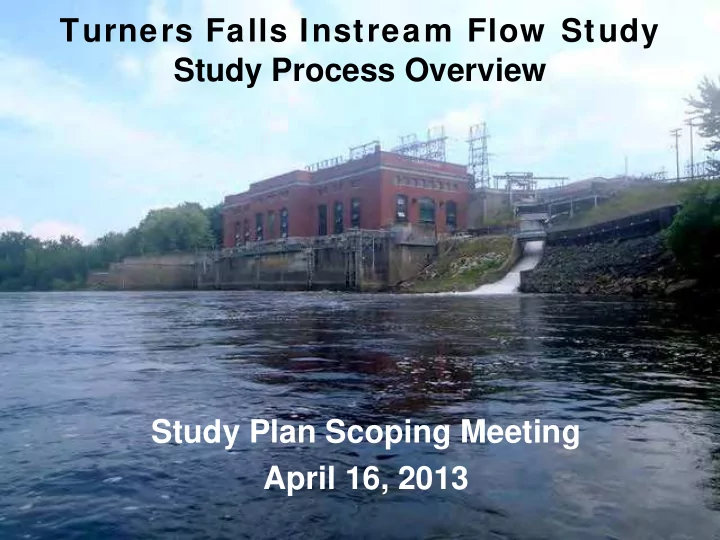

Turners Falls Instream Flow Study Study Process Overview Study Plan Scoping Meeting April 16, 2013
Study Timing Relative to ILP schedule ILP Schedule • Proposed Study Plans (PSP): 4/15/13 • Study Plan Meeting: 5/14-15/13 • Additional Fish and Aquatic Meetings: 5/21-22, 6/4-5/13 • Seeking to conduct IFIM Study July timeframe • Comments due on PSP: 7/14/13 • Revised Study Plans (RSP): 8/13/13 • Comments due on RSP: 8/28/13 • FERC Issues Study Plan Determination Letter 9/12/13 (assuming no disputes) • We need stakeholder and FERC approval before initiating study Why Accelerate? • Findings will inform other studies, fish passage alternatives, and potential impacts on hydropower generation
TERMINOLOGY Macrohabitat – water quality and hydrology Mesohabitat – commonly occurring habitat types Critical habitat – important to a species even if not common Microhabitat – depth, velocity and cover within each mesohabitat Weighted Usable Area - quantitative index of habitat suitability
PHABSIM Study 1. Study Planning 2. Locate reaches and transects 3. Obtain channel profile and microhabitat data 4. Develop hydraulic model 5. Input suitability rating criteria 6. Output suitability available at each flow increment of interest
PHABSIM Study 1. Study Planning 2. Locate reaches and transects 3. Obtain channel profile and microhabitat data 4. Develop hydraulic model 5. Input suitability rating criteria 6. Output suitability available at each flow increment of interest
Hypothetical flow control issue Flow control downstream
Review physical characteristics Minor tributary Flow control Repeating channel Major tributary pattern: riffle/run/pool Unique channel condition: cobble rapids downstream
Link species/lifestages or guilds to specific mesohabitats
Define overall study area Flow control Juvenile and adult feeding and holding Spawning bar downstream
Stratify reaches according to physical, hydrologic and habitat use characteristics Flow control REACH 1 REACH 2 downstream
Select study sites representative of each reach Representative Flow control reach study site REACH 1 REACH 2 Critical reach study site downstream
Representative Study Site pool Sand bar riffle run
Cell Boundaries are located at breaks in habitat types pool riffle run
Cell Boundaries ( continued ) pool riffle run
One transect is located within each longitudinal cell T-5 pool T-4 riffle T-3 T-2 T-1 run
PHABSIM Study 1. Study Planning 2. Locate reaches and transects 3. Obtain channel profile and microhabitat data 4. Develop hydraulic model 5. Input suitability rating criteria 6. Output suitability available at each flow increment of interest
transect T-1 ( looking downstream ) headpin tailpin Top of bank Water surface Toe of bank Edge of water Thalweg
Verticals are located along each transect to capture key substrate and profile features headpin tailpin Top of bank Toe of bank Edge of water Thalweg
Verticals and cell boundaries act to divide each segment into a mosaic of known areas T-5 pool T-4 riffle T-3 T-2 T-1
SUBSTRATE CLASSIFICATION GRAVEL COBBLE
IMBEDDEDNESS highly imbedded un-imbedded
VELOCITY REFUGE Abundant refuges Few refuges
PHABSIM Study 1. Study Planning 2. Locate reaches and transects 3. Obtain channel profile and microhabitat data 4. Develop hydraulic model 5. Input suitability rating criteria 6. Output suitability available at each flow increment of interest
Calibration flows are gathered across the flow range of interest High flow ( WSL only ) mid flow ( WSL and velocities ) low flow ( WSL and some velocities )
This permits interpolation and extrapolation of other flows 1,800 cfs 100 cfs
PHABSIM Study 1. Study Planning 2. Locate reaches and transects 3. Obtain channel profile and microhabitat data 4. Develop hydraulic model 5. Input suitability rating criteria 6. Output suitability available at each flow increment of interest
Habitat Suitability Criteria • Depth • Velocity • Channel Index
Habitat is “pixilated” into a mosaic of known dimensions
2D Finite Elements Model Survey elevations bathymetry
2D Finite Elements Model Scenario “A” Scenario “B”
PHABSIM Study 1. Study Planning 2. Locate reaches and transects 3. Obtain channel profile and microhabitat data 4. Develop hydraulic model 5. Input suitability rating criteria 6. Output suitability available at each flow increment of interest
Model output: Habitat-flow relationships for each study reach 25000 Pleasant River IFIM Study. Habitat and wetted area vs. flow relationship in mid-river (Reach No. 4) riffle run (Sq Ft per 1,000 ft of stream). 20000 Habitat Suitability (WUA ) YOY Parr 15000 10000 5000 0 0 100 200 300 400 500 600 Discharge (cfs)
Suggested Problem-Solving Process Review hydrology time series Compare habitat under existing and alternate flow scenarios Compare project operation under existing and alternate flow scenarios Assess extent to which all objectives are met under each flow scenario Evaluate trade-offs Re-run alternative scenarios
Problem-Solving Options • Habitat Time Series – Define applicable bio-periods – develop flow duration data for each – Merge WUA/flow curve with flow duration curve – Look for alternatives that meet habitat and operation objectives • Persistent Habitat Analysis – Map spatial distribution of habitat “hotspots” at paired flows in GIS – Look for pair combinations that provide consistently good habitat – Develop matrix for species/lifestages – Iteratively look for scenarios that balance both operation and habitat objectives
Habitat suitability relationship July - September habitat suitability 400 weighted usable area (SQ FT) 360 320 280 RBT adult 240 200 0 200 400 600 800 discharge (CFS)
Hydrologic Data
Hydrograph + habitat 22000 Area ft2/1000ft 20000 Weighted Usable 18000 Natural 16000 14000 0 10 20 30 40 50 60 70 80 90 100 % of time streamflow was equaled or exceeded
Effect of existing flow diversion 22000 Weighted Usable Area ft2/1000ft 20000 18000 Natural 16000 "worst case" current practice 14000 0 10 20 30 40 50 60 70 80 90 100 % of time streamflow was equaled or exceeded
Effect of alternative diversion strategies 22000 Weighted Usable Area ft2/1000ft 20000 18000 Natural current practice Alternative "A" 16000 Alternative "B" Alternative "C" 14000 0 10 20 30 40 50 60 70 80 90 100 % of time streamflow was equaled or exceeded
Persistent Habitat
Persistent Habitat
Recommend
More recommend